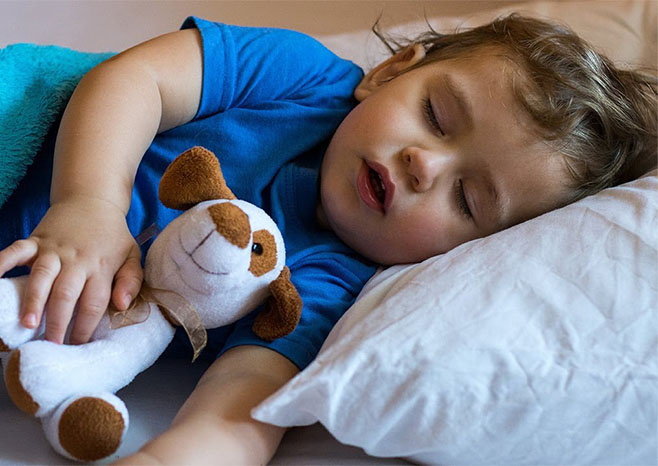Treatment Options for Pediatric Obstructive Sleep Apnea

Diagnosing pediatric obstructive sleep apnea (OSA) includes reviewing a child’s symptoms, their medical history, and conducting a physical exam.
Once OSA has been diagnosed there are various treatment approaches depending on a child’s symptoms, age, overall health, and severity of symptoms. This article discusses treatment options including non-surgical and surgical intervention.
Non-Surgical Treatments for Pediatric OSA
If a child has mild sleep apnea linked to allergies, various medications can be used to improve the severity of respiratory disturbances. Medication options such as anti-inflammatories or nasal steroids may be prescribed depending on the cause of the sleep apnea,1 however the efficacy is not proven with concrete evidence.
Tonsillectomy
The American Academy of Otolaryngology-Head and Neck Surgery describes a tonsillectomy as a surgical procedure, performed with or without adenoidectomy, which removes the tonsil2.
It is now widely acknowledged that a factor that can lead to obstructive sleep apnea (OSA) in children is the hypertrophy of lymphoid tissues in the upper airway3. As such, an adenotonsillectomy is the initial treatment recommended by the American Academy of Otolaryngology-Head and Neck Surgery4.
COBLATION ◊ technology is one of many methods that can be used to remove the tonsil5. It is used to precisely remove tissue at the molecular level by combining low-temperature radiofrequency energy with saline6-8. This results in minimized damage to surrounding tissue7*.
When considering a tonsillectomy, surgeons and ENTs are presented with two options: intracapsular tonsillectomy or total tonsillectomy.
Intracapsular Tonsillectomy
COBLATION intracapsular tonsillectomy involves removing all the tonsil tissue using a COBLATION wand while leaving the integrity of the tonsil capsule. The tonsil capsule refers to the slender, fibrous tissue that acts as a barrier between the tonsil and the underlying muscle.
Studies have shown that there are multiple post-operative benefits to leaving the tonsil capsule in place. They include a 64% reduction in risk of post tonsillectomy hemorrhage (PTH), being pain-free 4.2 days sooner, and a low, 2.2% rate of revision at five years post-operatively8-15.
By choosing COBLATION intracapsular tonsillectomy, surgeons can reduce the likelihood of post-operative complications while maintaining the procedure’s efficacy compared to total tonsillectomy. The popularity of this approach is growing, with 20% of pediatric ENT surgeons in the United States incorporating it into their practice16.
Total Tonsillectomy
In contrast to COBLATION intracapsular tonsillectomy, total tonsillectomy involves the complete removal of all tonsil tissue, including both the lymphatic tissue and the underlying capsule. The choice of technology in this procedure can impact outcomes for patients5,15-17.
COBLATION technology offers a key advantage by empowering surgeons to precisely remove targeted tonsil tissue using a controlled, lower-temperature plasma field7,8,18-21. This precision ensures the preservation of adjacent healthy tissue, leading to a more comfortable post-operative recovery compared to alternative techniques**6-8,17,22,23. Additional benefits include a minimal risk of post-tonsillectomy hemorrhage (PTH) and re-admission11.
Several COBLATION wands are available to accommodate diverse surgical preferences, each operating at lower temperatures compared to instruments like electrocautery. This results in reduced thermal damage and a more comfortable recovery**6,17,22,23.
If your pediatric patients have enlarged tonsils and are experiencing symptoms of OSA, consider exploring COBLATION Technology.
Disclaimer: Smith+Nephew does not provide medical advice. The information presented is not, and is not intended to serve as, medical advice. It is the responsibility of healthcare professionals to determine and utilize the appropriate products and techniques according to their own clinical judgment for each of their patients. The information presented may not be appropriate for all jurisdictions.
*In comparison to monopolar electrocautery, CO2 laser and bipolar diathermy
**Lower-temperature compared to monopolar RF technologies and Laser technologies
1. Kuhle S, Hoffman DU, Mitra S, Urschitz MS. Anti-inflammatory medications for obstructive sleep apnoea in children. Cochrane Database Syst. Rev. 2020;1(1):CD007074.
2. AAO-HNS. Tonsillectomy in children: update to guidelines for treating and managing care. Available at: https://www.entnet.org/resource/aao-hnsf-updated-cpg-tonsillectomy-press-release-fact-sheet/. Accessed March 14, 2024.
3. Mayo Clinic. Pediatric obstructive sleep apnea. Available at: https://www.mayoclinic.org/diseases-conditions/pediatric-sleep-apnea/symptoms-causes/syc-20376196. Accessed March 14, 2024.
4. AAO-HNS. Position statement: tonsillectomy and OSAs. Available at: https://www.entnet.org/resource/position-statment-tonsillectomy-and-osas/. Accessed March 14, 2024.
5. Chan KH, Friedman NR, Allen GC, et al. Randomized, controlled, multisite study of intracapsular tonsillectomy using low-temperature plasma excision. Arch Otolaryngol Head Neck Surg. 2004;130(11):1303–7.
6. Smith+Nephew 2017. Coblation Dissection Versus Monopolar Dissection — A Systematic Review and Meta-analysis. Internal Report. P/N 91999.
7. Roje Z, Racic G, Dogas Z, Pisac VP, Timms MS. Postoperative Morbidity and Histopathologic Characteristics of Tonsillar Tissue Following Coblation Tonsillectomy in Children: A Prospective Randomized Single-Blind Study. Coll Antropol. 2009;33(1):293 – 298.
8. Magdy EA, Elwany S, El-Daly AS, Abdel-Hadi M, Morshedy MA. Coblation tonsillectomy: a prospective, double-blind, randomised, clinical and histopathological comparison with dissection–ligation, monopolar electrocautery and laser tonsillectomies. J Laryngol Otol. 2008;122(3):282 – 290.
9. Sedgwick MJ, Saunders C, Bateman N. Intracapsular Tonsillectomy Using Plasma Ablation Versus Total Tonsillectomy: A Systematic Literature Review and Meta-Analysis. OTO Open. 2023;7(1):e22.
10. Amin N, Bhargava E, Prentice JG, Shamil E, Walsh M, Tweedie DJ. Coblation Intracapsular Tonsillectomy in Children: A Prospective Study of 1257 Consecutive Cases with Long Term Follow Up. Clin Otolaryngol. 2021;46(6):1184-1192.
11. Francis DO, Fonnesbeck C, Sathe N, McPheeters M, Krishnaswami S, Chinnadurai S. Postoperative Bleeding and Associated Utilization Following Tonsillectomy in Children: A Systematic Review and MetaAnalysis. Otolaryngol Head Neck Surg. 2017;156(3):442-455
12. Varadharajan K, Caton N, Faulkner J, Khemani S. Coblation® intracapsular tonsillectomy in children with recurrent tonsillitis: Initial experience. Int J Pediatr Otorhinolaryngol. 2020;135:110113.
13. Chau SM, Sharma GK, Ahuja GS, Huoh KC, Pham NS. Post-Operative Hemorrhage Rates in Coblation Intracapsular Tonsillectomy: A 6-year Experience. Poster presented at: Combined Otolaryngology Spring Meetings (COSM); May 1-5, 2019; Austin, Texas.
14. Albright JT, Duncan NO, Smerica AM, Edmonds JL. Intra-capsular complete tonsillectomy, a modification of surgical technique to eliminate delayed post-operative bleeding. Int J Pediatr Otorhinolaryngol. 2020;128:109703.
15. Keltie K, Donne A, Daniel M, et al. Paediatric tonsillectomy in England: A cohort study of clinical practice and outcomes using Hospital Episode Statistics data (2008-2019). Clin Otolaryngol. 2021;46(3):552-561.
16. Huoh, K, Haidar, Y, Dunn, B. Current Status and Future Trends: Pediatric Intracapsular Tonsillectomy in the United States. The Laryngoscope. 2021;131 Suppl 2:S1-S9.
17. Temple RH, Timms MS. Paediatric coblation tonsillectomy. Int J Pediatr Otorhinolaryngol. 2001;61(3):195–198
18. Smith+Nephew 2010. PROCISE LW & MLW, Thermal Measurement and Comparison to CO2 and KTP Laser Systems. Internal Report. P/N 86257 Rev. A.
19. Smith+Nephew 2010. PROcise XP Comparative Thermal Measurement Bench-Top Study. Internal Report. P/N 60736-01 Rev. A.
20. Smith+Nephew 2010. ENTceps® and Evac 70 Xtra Comparative Engineering Study. Internal Report. PN 69832 Rev. A.
21. Smith+Nephew 2010. Temperature Study – PEAK PlasmaBlade® TnA and Covidien EDGE®. Internal Report. PN 86791 Rev. 1.
22. Ahmad MU, Wardak AN, Hampton T, Siddiqui MRS, Street I. Coblation versus cold dissection in paediatric tonsillectomy: a systematic review and meta-analysis. J Laryngol Otol. 2020;134(3):197 – 204.
23. Parsons SP, Cordes SR, Comer B. Comparison of Posttonsillectomy Pain Using the Ultrasonic Scalpel, Coblator, and Electrocautery. Otolaryngol Head Neck Surg. 2006;134(1):106 – 113.


